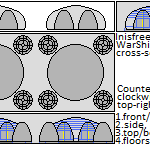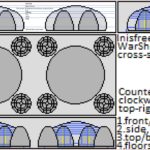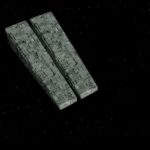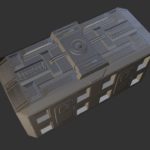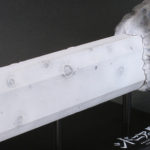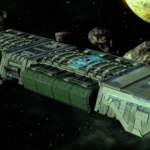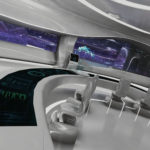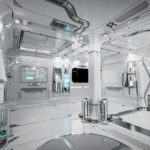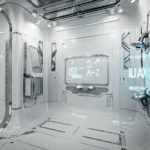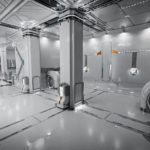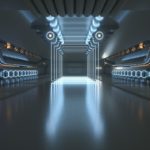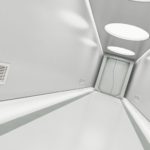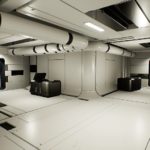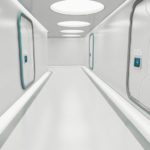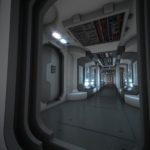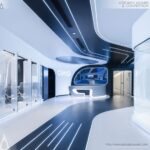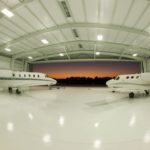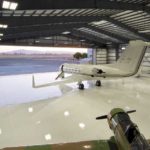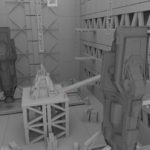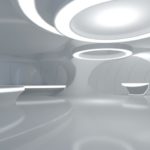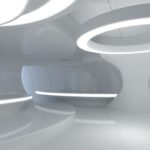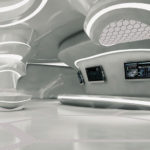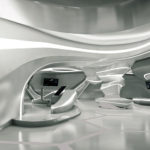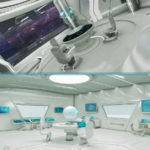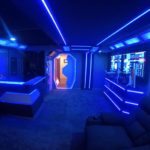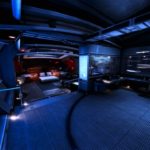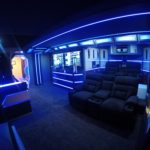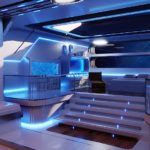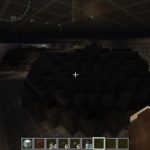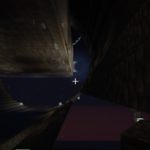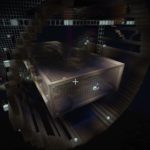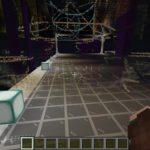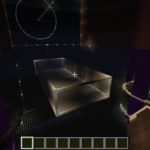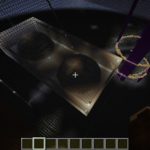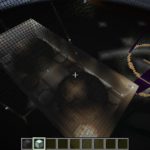Picture a spaceship a mile wide, a third of a mile tall, and two miles long.
–
Table of Contents:
- Introduction
- Dimensions & Layout
- (Former) Vertical Layout & Primary Inventory Items
- Total Complement
- Repulsines
- Additional Notes
- Special Features
- Appearance Modes
- Time to Construct
- History
- Design & Locations (Images Begin)
- External Appearance
- Command-areas Concepts
- Docking-areas Concepts
- Hallway Appearances
- Hangar Appearances
- Kajirae Holding-rooms Appearances
- Public/Passenger-use Areas
- Suites Appearances
- Scale-model in Minecraft
–
Introduction:
Though all Inisfreean (IC) vessels may be used as warships, all Inisfreean vessels smaller than these titled WarShips are traditionally reserved for purposes other than full-scale wars; Inisfreean ColonyPods (CPs) are used to smash an enemy city, land on its ruins, then biomechanically grow a replacement city out radially from the landing site, while Inisfreean DropShips (DSs) are used to quickly put a mobile F.O.B. with a squadron and a brigade of Inisfreean troops on the ground. Inisfreean WarShips (WSs) each carry two CPs and eight DSs; enough to put air wings, brigades, and two full-sized cities on the ground in a matter of minutes –even from as distant as high orbit. Thus, WSs are usually only seen in action when wars, not mere battles or skirmishes, erupt, requiring major, long-term presences, blocking major supply channels (on the scale of highways and shipping lanes), reclaiming national borders, and establishing permanent urban centers for indefinite industrial support for all nearby forces for however much time the war in question ends up taking. This way, footholds are much more easily maintained, and teleportation (such as by man-made (Inisfreean-made, in this case) worm-holes) is usually seldom needed, if at all; this allows for conservation of energy, and concealment of more advanced technology and techniques.
An IC WS is deployed whenever there is Space warfare on the ocean level down to the continent level; when ships of this scale are not over-qualified and under-utilized.
–
Dimensions & Layout:
WSs are rectangular prisms measuring about 2 miles x 1 mile x 1/3 of a mile. Their underbelly has the 10 circular hatches for their ‘child’ vessels; again, each ‘parent’ vessel (the WSs) houses two CPs and eight DSs. It is also of note that since every CP carries four DSs, every WS actually has not eight DSs, but 16.
- Depth (‘Length’): ~10,500′
- Width: ~5,200′
- Height: ~1,700′
- Floorspace: (see below for details)
- Stories: 113
- Total Floorspace: ~5,995,400,000 sq.ft. (the sum for/of all 113 levels)
- Personnel: 50,000,000 IC MFs (and 93,937,160 MFs total (thus nearly as many as the 100M that typically garrison/crew Inisfree and any of our Inisfree-like cities), if you count the crews of the 2 CPs and 8 DSs (43,937,160 ICVs; [(2 x 12,712,200) + (8 x 2,314,145)]) housed in a WS)
- Dispersion: ~1 IC MF per 120 sq.ft.; ~1 IC MF per 11′ x 11′ area (1,710,666,000 sq.ft. / 50,000,000 IC MFs) if evenly dispersed
- Overall Layout: rectangular prism with 2 CP hangars and 8 DS hangars, all arranged into two square formations along its underside, with multiple AIOWs throughout, and with its heaviest ‘rainbow-cannon’ (full-spectrum next-gen’ laser) running from bow to stern just under the top
Main Sections:
- double-hull; even if the outer hull was breached/penetrated, it would not depressurize any hangars (which don’t have atmospheres/pressure, anyway; ICVs and other ICs don’t need them)
- big-ship hangars; for the 8 DSs and 2 CPs (and all 10 of these hangars are double-hull like the whole WS)
- repulsines; ~400′ diameter (the size of an average stadium, if sphered)
- floors for rooms/suites and smaller craft; 113 floors/levels of them, all connected by 16 BM-sized/wide service-lifts (elevators)
Every floor is connected to the other floors via service-lifts; at 16 locations.
Every floor has hallways (which are all wide enough for 2 human-sized people walking side by side; hallways are ~5′ wide) connecting/separating its hangars and/or suites.
Hangars on all floors are aligned in a grid, keeping uniform rows and columns all the way along between opposite sides of the WS. While no IC vehicle requires this alignment (as all of them can portal themselves), this facilitates easy traversing if ever a situation calls for no portal-ing; hangar doors can be opened to allow the craft/vehicles inside to drive or hover out… until they are, for example, at a service-lift or outer/external hatch.
Sections/Groups of Floors:
- Docking floors; where a WS connects to the inside wall/curve of a WS/Uber Hangar in a CSBS such as Inisfree
- Main Guns floors; where the 2 2-miles-long Rainbow Cannons are
- Command & Kajirae floors; where the cockpit is, and where suites (each of which includes an automated container-farm room/annex; so every passenger has a lifetime anytime-access supply of fresh healthy vegan food) for passengers are
- FJ Hangars floors; where the IC fighter-jets are serviced
- MPHA Hangars floors; where most of the IC cargo-airships are serviced
- TK Hangars floors; where most of the IC tanks are serviced
- WR Hangars floors; where most of the IC APCs are serviced
- BM Hangars floors; where the IC battlemechs are serviced, and where the (~400′-tall) waterfalls are (1 per BM-hangar (thus 260 total in each WS), always where the BM is facing, only flowing when a non-ICV passenger/guest wants to visit one of these hangars, and only visible when that hangar’s visible-spectrum lights are turned on)
- Bombardment floors; for the BMs to enter/exit directly to their pads/stations in the section above it (and this section is called Orbital Bombardment because it is the one almost always facing the planet being orbited, thus it is where the most Inisfreean craft/forces deploy/release from; the exiting/detaching DSs and CPs)
Floors by Section:
- Docking: 25 pixels; ~225′; 25 ~9′ floors
- Main Guns: 12 pixels; ~108′; 12 ~9′ floors
- Command & Kajirae: 12 pixels; ~108′; 12 ~9′ floors
- FJs: 12 pixels; ~108′; 12 ~9′ floors
- MPHAs: 12 pixels; ~108′; 3 ~36′ floors; tall enough for an MPHA
- TKs: 12 pixels; ~108′; 6 ~18′ floors
- WRs: 12 pixels; ~108′; 6 ~18′ floors
- BMs: 53 pixels; ~484′; 1 500′ floor that extends ~30′ down only beneath each BM pad/station
- Bombardment: 36 pixels; ~329′; 36 ~9′ floors
- Total Floors: 113
DS & CP Hangar-space by Section:
- Main Guns: [(~1,228′-diameter circle x 2) = (1,180,000 sq.ft. x 2) = 2,360,000 sq.ft.]
- Command & Kajirae: [(~2,416′-diameter circle x 2) = (4,580,000 sq.ft. x 2) = 9,160,000 sq.ft.]
- FJs: [(~2,812′-diameter circle x 2) + (~568′-diameter circle x 8) = (6,210,000 sq.ft. x 2) + (253,000 sq.ft. x 8) = (12,420,000 sq.ft. + 2,024,000 sq.ft.) = 14,444,000 sq.ft.]
- MPHAs: [(~3,208′-diameter circle x 2) + (~832′-diameter circle x 8) = (8,080,000 sq.ft. x 2) + (544,000 sq.ft. x 8) = (16,160,000 sq.ft. + 4,352,000 sq.ft.) = 20,512,000 sq.ft.]
- TKs: [(~3,472′-diameter circle x 2) + (~964′-diameter circle x 8) = (9,470,000 sq.ft. x 2) + (730,000 sq.ft. x 8) = (18,940,000 sq.ft. + 5,840,000 sq.ft.) = 24,780,000 sq.ft.]
- WRs: [(~3,736′-diameter circle x 2) + (~1,096′-diameter circle x 8) = (11,000,000 sq.ft. x 2) + (943,000 sq.ft. x 8) = (22,000,000 sq.ft. + 7,544,000 sq.ft.) = 29,544,000 sq.ft.]
- BMs: [(~4,000′-diameter circle x 2) + (~1,360′-diameter circle x 8) = (12,600,000 sq.ft. x 2) + (1,450,000 sq.ft. x 8) = (25,200,000 sq.ft. + 11,600,000 sq.ft.) = 36,800,000 sq.ft.]
- Bombardment: [(~4,000′-diameter circle x 2) + (~1,360′-diameter circle x 8) = (12,600,000 sq.ft. x 2) + (1,450,000 sq.ft. x 8) = (25,200,000 sq.ft. + 11,600,000 sq.ft.) = 36,800,000 sq.ft.]
Floorspace by Section:
[(10,500′ x 5,200′) x floors – (DS & CP Hangar-space)]
- Docking: [(54,600,000 sq.ft.) x 25 floors – (0 sq.ft.)] = (1,365,000,000 – 0) = 1,365,000,000 sq.ft. available (not used by a DS or CP hangar) for vehicles/personnel
- Main Guns: [(54,600,000 sq.ft.) x 12 floors – (2,360,000 sq.ft.)] = (655,200,000 – 2,360,000) = 652,840,000 sq.ft. available (not used by a DS or CP hangar) for vehicles/personnel
- Command & Kajirae: [(54,600,000 sq.ft.) x 12 floors – (9,160,000 sq.ft.)] = (655,200,000 – 9,160,000) = 646,040,000 sq.ft. available (not used by a DS or CP hangar) for vehicles/personnel
- FJs: [(54,600,000 sq.ft.) x 12 floors – (14,444,000 sq.ft.)] = (655,200,000 – 14,444,000) = 640,756,000 sq.ft. available (not used by a DS or CP hangar) for vehicles/personnel
- MPHAs: [(54,600,000 sq.ft.) x 3 floors – (20,512,000 sq.ft.)] = (163,800,000 – 20,512,000) = 143,288,000 sq.ft. available (not used by a DS or CP hangar) for vehicles/personnel
- TKs: [(54,600,000 sq.ft.) x 6 floors – (24,780,000 sq.ft.)] = (327,600,000 – 24,780,000) = 302,820,000 sq.ft. available (not used by a DS or CP hangar) for vehicles/personnel
- WRs: [(54,600,000 sq.ft.) x 6 floors – (29,544,000 sq.ft.)] = (327,600,000 – 29,544,000) = 298,056,000 sq.ft. available (not used by a DS or CP hangar) for vehicles/personnel
- BMs: [(54,600,000 sq.ft.) x 1 floors – (36,800,000 sq.ft.)] = (54,600,000 – 36,800,000) = 17,800,000 sq.ft. available (not used by a DS or CP hangar) for vehicles/personnel
- Bombardment: [(54,600,000 sq.ft.) x 36 floors – (36,800,000 sq.ft.)] = (1,965,600,000 – 36,800,000) = 1,928,800,000 sq.ft. available (not used by a DS or CP hangar) for vehicles/personnel
- Total Floorspace: 5,995,400,000 sq.ft.
Individual Craft/Vehicle Floorspace Needs:
- ICV: 9 sq.ft. (3′ x 3′)
- FJ: 600 sq.ft. (20′ x 30′; ~5′ on all sides)
- MPHA: 9,900 sq.ft. (90′ x 110′; ~5′ on all sides)
- TK: 800 sq.ft. (20′ x 40′; ~5′ on all sides)
- WR: 1,500 sq.ft. (25′ x 60′; ~5′ on all sides)
- BM: 18,400 sq.ft. (115′ x 160′; ~20′ on all sides)
Total Craft/Vehicle Floorspace Needs:
- ICVs: 9 sq.ft. x 50,000,000 ICVs = 450,000,000 sq.ft. needed for all ICVs (of 652,840,000 sq.ft. available in the Main Guns section; 202,840,000 sq.ft. surplus throughout these ~9′-tall floors)
- FJs: 600 sq.ft. x 266,660 FJs = 159,996,000 sq.ft. needed for all FJs (of 640,756,000 sq.ft. available; 480,760,000 sq.ft. surplus throughout these ~9′-tall floors)
- MPHAs: 9,900 sq.ft. x 66,660 MPHAs = 659,934,000 sq.ft. needed for all MPHAs (of 143,288,000 sq.ft. available –thus the remaining needed 516,646,000 sq.ft. is in the FJs section and Command section, both above the MPHAs section)
- TKs: 800 sq.ft. x 1,333,330 TKs = 1,066,664,000 sq.ft. needed for all TKs (of 302,820,000 sq.ft. available –thus the remaining needed 763,844,000 sq.ft. is in the Docking section; 1,365,000,000 sq.ft. up there)
- WRs: 1,500 sq.ft. x 666,660 WRs = 999,990,000 sq.ft. needed for all WRs (of 298,056,000 sq.ft. available –thus the remaining needed 701,934,000 sq.ft. is in the Bombardment section; 1,928,800,000 sq.ft. down there)
- BMs: 18,400 sq.ft. x 260 BMs = 4,784,000 sq.ft. needed for all BMs (of 17,800,000 sq.ft. available; 13,016,000 sq.ft. surplus throughout this ~484′-tall floor)
Resulting Vehicles Placement by Section:
- Docking: TKs
- Main Guns: ICVs
- Command & Kajirae: MPHAs
- FJs: FJs, MPHAs
- MPHAs: MPHAs
- TKs: TKs
- WRs: WRs
- BMs: BMs
- Bombardment: BMs (just their feet/boots), WRs
DS, CP, and WS levels closely align/match, keeping their respective vehicles (largely) on similar/identical levels/floors.
Every person (ICV) and vehicle (from the FJs all the way up to the BMs) is in its own hangar (or stasis-tube, in the case of ICVs; 1 ICV per stasis-tube); this prevents any from sliding around or bumping into others, no matter the maneuvers of the WS.
Even with some MPHA-hangars being on the Command & Kajirae section’s floors/levels, there is still ~610,154,000 square feet available. That is used in the following ways:
- for 1 ~33′-diameter cockpit module (855.3 sq.ft.) staffed by numerous ICVs helping coordinate all subordinate craft/ICs/ICVs and all adjacent/allied/fleet ships/vessels
- for apartment-like suites to ensure any passengers are comfortable, well fed, entertained, and able to get restful sleep (610,154,000 sq.ft. – 855.3 sq.ft. = 610,153,144.7, and with most luxury-apartments having ~400 sq.ft. (~20′ x 20′), that’s room for >1,525,000 of them, so just as many individuals if all of them wanted their own room/apartment, or up to 6,100,000 comfortably (4 per 400-sq.ft. apartment), and, of course, 24,400,000 if everyone was given a 10′ x 10′ space in those apartments, and even 73,200,000 (comparable to the total crew; 68,250,000 ICVs) if each of those 100-sq.ft. apartment-quadrants had a triple-bunkbed (3 twin-sized mattresses) in it)
–
(Former) Vertical Layout & Primary Inventory Items:
The following are now organized based on the information in the webpage section above.
- Top level: cockpit (9 IC MFs on living thrones made of 3D Celtic-style weaves of IC MFs; ~99 IC MFs total)
- Higher section: FJs (5,333,320 IC MFs inside 266,660 IC FJs)
- High section: MPHAs (3,466,320 IC MFs inside 66,660 IC MPHAs)
- Middle section: STs (21,161,141 IC MFs; Inisfreean Infantry units; ~1,000 divisions; ~5,000 regiments/brigades; ~25,000 battalions)
- Low section: TKs (7,999,980 IC MFs inside 1,333,330 IC TKs)
- Lower section: WRs (11,999,880 IC MFs inside 666,660 IC WRs)
- Lowest hangars: BMs (39,260 IC MFs inside 260 IC BMs)
- Bottom section: landing gear, etc.
–
Total Complement:
Tens of millions of personnel and millions of vehicles are carried by these ships.
- 50,000,000 troops (ICVs); 16,000 of our battalions (not including those in the 2 CPs or 8 DSs)
- 1,333,330 tanks (TKs)
- 666,660 APCs (WRs)
- 266,660 fighter-jets (FJs)
- 66,660 cargo aircraft (MPHAs)
- 260 BattleMechs (BMs)
* Tonnage & composition are classified.
–
Repulsines:
In craft of this size, these drives/engines are each ~400′ across (diameter). Each WS has 8 of them. 4 are in the vertices of the top of the WS, and the other 4 are in the middles of the bottom edges (which provides them enough space, since the insides of the lower 4 vertices of a WS are partially occupied by DS hangars). They are naturally and effortlessly in an “on and idle” state; they are almost always spinning at least enough to keep the entire weight of their WS canceled out, its shield/s powerful enough to deflect/convert anything, and the whole ship invisible to most, if not all, forms of (human Outlander) detection.
–
Additional Notes:
Inisfreean WarShips do not go/land planet-side, so their vehicles (tanks and APCs) are rarely deployed (other than during The Mapping Campaign; when just about every IC was in use). The tanks and APCs kept in each WarShip are usually just for emergencies, typically to resupply/reinforce Inisfreean ground-positions/encampments/FOBs. Normally, any tank or APC needed from a WarShip will be moved via portal to where it is needed; they don’t need to drive or hover through their WarShip to get to a hatch, lift, or vessel/transport.
–
Special Features:
Beams Skipping Gaps: Like most Inisfreean vessels, WSs can fire accurately in every direction at the same time, including through virtually countless portals, to overwhelm and confuse the most intense swarms of any enemy forces. Portals can even be opened to fire back toward a WS, such that what it fires out will appear to be disappearing at certain points, reappearing at others, and racing right back in toward it. Because of its ‘smart’-projectiles, including ‘smart’-energy-beams (such as ‘smart’-lasers and ‘smart’-masers), ‘friendly fire’ cannot occur; impacts from Inisfreean projectiles cannot harm Inisfreean vessels or personnel.
…
Helpful Elevators: The service-lifts (elevators) are designed with multiple handholds (handlebars), footholds (boot bars and a magnetizing/gripping ‘smart’-surface option), and other features for balance, control, and safety. Being part of a self-aware ship, these lifts know where you intend to go, so you don’t have to worry about accidentally pushing the button for a wrong floor and ending up hundreds of feet higher or lower than you intended to go. Like all other areas/rooms of this ship, the lights will automatically turn on for non-ICVs stepping in, and turn themselves back off the moment you are stepping out and no longer in need of them.
…
Air Only in Some Spots: There is no breathable air/atmosphere anywhere in a WS except for the suites and floors where human/oid (non-ICV) passengers (such as kajirae) are being housed/healed. Because of that, every internal hatch is an airlock, and every hatch-display (LCD) always shows in multiple languages alerts/warnings about what conditions are like on the other side. The ship (WS) is intelligent, though (A.I.), so there’s no need to worry about accidentally opening the wrong hatch (i.e. one that goes to an environment/floor/hangar which the person intending to use that hatch is not properly suited up to survive in).
…
Gravity Only in Some Spots: ICVs have no need for gravity, given their natural repulsine-organs/body-parts, so there will only be generated/regulated gravity where non-ICV passengers are. This means even the cockpit doesn’t have any –unless a non-ICV, such as High King Auz, decided to walk in there (and, even then, only if he requested/ordered/activated it).
…
Crew Bypasses: ICVs don’t walk through the hallways of this ship, as opening portals for themselves is as easy as it is for a human to blink, breathe, or think; when an ICV needs to go somewhere in this ship, she just thinks about the location… and appears there. Inisfreean portals-technology is so sophisticated that it requires virtually no energy/effort on the part of any ICV or other IC/vessel. It isn’t based on bending/warping space, either, so there is no risk to anyone nearby, no matter how many times ICVs or other ICs are portal-ing around them –and the network of ICVs/ICs is always aware of who and what is where at both their starting points and destinations, so collisions never occur.
…
Passenger Bypasses: Unless the passenger is a free-person (non-kajira or non-kajira-candidate), an ICV will use a portal to get him/her directly to/from his/her room/suite. This is, in part, to save time. It is also, of course, to help maintain OPSEC via physical compartmentalization; it decreases the number of people who have walked through the ship, thus most have no idea how any of the other rooms or levels of the ship are –or how they are arranged or connected. (The exception is that during the offloading of kajirae-candidates after a Voyage of Acquisition, to help exercise and tire those acquired girls, ICVs will escort/march them out of their suites, through the ship, to the Docking-section hatches, and through those hatches to either the Silos Network tunnels… or the Glowing Art Highway transports awaiting them.)
…
The Big Guns: Because the main-gun of a DS, and the main-gun of a CP, both aim out the center of the bottom of those crafts, and because their range is thousands of miles, when all the DSs and CPs are docked in a WS, all 16 DSs’ main-gun beams, and the 2 CPs’ main-gun beams, can fire at the planet being orbited. This is another reason the lowest section of floors/levels of a WS is known as the Orbital Bombardment section.
DS Rainbow Cannon ranges:
- main-gun range: ~119,450 miles
- non-main range: ~180 miles
CP Rainbow Cannon ranges:
- main-gun range: ~238,900 miles
- non-main range: ~180 miles
For reference, the distance between Earth and the Moon is 238,900 miles, satellites are 12,700 miles away, and Space ends 62 miles above (or below, as Inisfreeans think of it; Space is The Abyss, and The Abyss is a pit, thus down) the Earth; once a WS is as close to any planet as the Moon is to the Earth, all cities on that planet are within range of its CPs, and once that WS is within 180 miles of the planet… all cities on that planet are also within range of its DSs, so a single barrage from them could delete… or align/enlighten/heal/stabilize… 2 entire cities + the biggest skyscraper of 16 other cities all at the same time, within about 2-3 seconds.
Anytime a WS orients either of its small ends toward a target, such as a planet, it is likely about to destroy or heal a state, region, or sea-sized target (but not an area as big as a continent or ocean) in a single shot/second.
–
Appearance Modes
Like all ST and AP suits, Inisfreean WSs have the following appearance and cloaking options:
- Basic / Nude (matte white)
- Cloaked (transparent, showing Outer Space straight through it)
- Masked (disguised as an asteroid or comet)
- Nova (flashing with the brightness of a star in order to surprise, disorient, or even blind nearby enemies, or remaining as bright as a normal star)
Inside the WS, no lights are on anywhere other than where non-ICV passengers are residing; ICVs and other ICs have no need for visible-spectrum lighting.
–
* All Inisfreean Spaceships at and above the DropShip size have the following luxury features in them:
- anchored plant pots and landscaping with containment ‘energy-hoops’ (similar concept to a hoop-house crop-row covering, but invisible and only active during rapid maneuvers)
- anchored red carpets
- banners (long, hanging, with the Inisfree sigil centered on them)
- fluted columns framing hatches (doors)
- framed paintings (digital) and hologram projectors
- furs (artificial; vegan)
- marble fountains
- jacuzzis
- sconces
- throws (bed decorations)
- velvet ropes (such as are seen in VIP drop-off walk-ways and related areas)
- waterfalls
–
Time to Construct:
It takes ~1.5 seasons to 3D-print one of these ships. On the Inisfreean 13-month calendar, that’s 4.875 months (136.5 days). That means that every ~1.365 days… another 1% gets completed.
- ~22.75 days; days 1 through 23: “bones”; frame/skeleton
- ~22.75 days; days 23 through 46: “tendons”; secondary conduits/pipes, etc. (as the frame/skeleton is based on the Grid Mind mesh/tentacles; the frame of every Inisfreean vessel/construct doubles as its plumbing and electrical wiring)
- ~22.75 days; days 46 through 69: “muscles”; hatches, VTOL shafts, etc.
- ~22.75 days; days 69 through 91: “organs”; repulsines, Vril reactor/batteries, etc.
- ~22.75 days; days 91 through 114: vehicles/craft; its aerospacecraft, land vehicles, etc.
- ~22.75 days; days 114 through 136.5: personnel; Inisfreeans (ICVs) stationed in its stasis tubes
–
History:
The first Inisfreean WarShips were printed during September of 2011; those were the ones in the city’s upper set of 8 WarShip hangars (a.k.a. the Uber Hangars). By the end of January 2012, Inisfree had its first group/fleet of these ships. The rest it can fit in its WarShip hangars started a bit later, thus were finished/completed later.
The second set of Inisfreean WarShips was started in November of 2011; those were the ones stationed in Inisfree’s lower set of these hangars. This second set of WarShips was completed in March of 2012. Inisfree had the next nine months to test and load them up in preparation for The Rapture campaign (though only 5 of them were tasked with deploying to complete that operation).
As SSA was formed/built, newer groups/fleets of these ships were 3D-printed; each Inisfree-like city printed its own, as did each MSBS, then the PSBSs, and finally the SSBS that had formed them all (the PSBSs, followed by their MSBSs).
By 2200 A.D., there were trillions of them –and there would never be any more; their number was set, as foreseen.
–
Design & Locations:
–
External Appearance:
–
Command-areas Concepts:
–
Docking-areas Concepts:
–
Hallway Appearances:
–
Hangar Appearances:
–
Kajirae Holding-rooms Appearances:
–
Public/Passenger-use Areas:
–
Suites Appearances:
–
Scale-model in Minecraft:
This image shows a version of our WS with translucent sides, allowing you to see how much room the 2 CPs and 8 DSs take up when docked inside it.
–

